How to improve posture with the Alexander Technique: part 2
WARNING: this will seriously improve your drumming
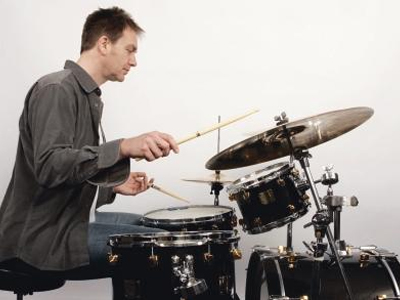
In 'how to improve posture with the Alexander Technique: part 1', we discovered that changing your thinking will change your body. Here's the concluding part…
By thinking about how we carry out any activity, including playing the drums, we can reduce unnecessary tension held in the body - most often it's tension we're not even aware of.
Change your thinking
Here's a little thinking exercise, which you can try with the help of a friend (non-drummers will be fine!). Hold your arm out straight at shoulder level. Now think of your arm as a bar of steel, but don't tense the muscles. Now ask your friend to try to push the arm down, as in the image below.
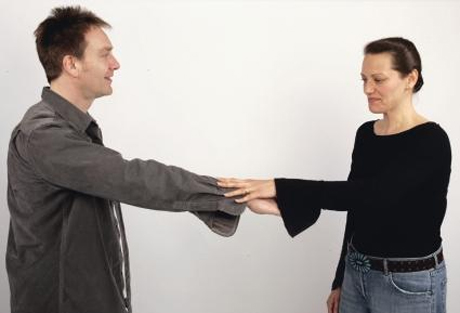
Repeat this exercise, but this time, think of your arm as being soft, and light as a feather. It'll be much easier to push down as you feel powerless to resist, and your friend may think that he or she has suddenly acquired a Kryptonian kind of strength!
However, fear not, this happens all because you changed your thinking. This is a key factor in Alexander Technique and should always be in mind throughout this article.
Find the middle
Many people think of the waist as being the middle part of the body. However, if you paid attention during biology lessons, you'll know that the middle of the body is, in fact, at the hip joints, which form part of the pelvis, as shown in image below.
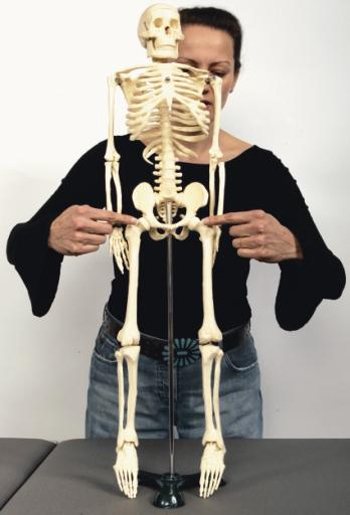
In other words, you should think of the pelvis as part of the upper body, not just as a unit with the legs. Thinking in this way can help stabilise the whole upper body which, in turn, allows for more physical freedom, independence, and control, of the arms and legs.
Want all the hottest music and gear news, reviews, deals, features and more, direct to your inbox? Sign up here.
So, when you're playing drums, think about really letting your arms and legs move freely and easily out of the torso, and you'll notice the physical benefits. Have another look at the skeleton above, to familiarise yourself with the position of the pelvis as part of the upper body.
A swinging hip joint
We can't stress enough the need to maintain an upright but relaxed position when playing drums. If we need to move forward slightly, it's best to do this by allowing rotation of the hip joints rather than collapsing or folding the body into what is known as a 'crabbing' position. If you do notice yourself collapsing forward while playing, think about creating space across the upper chest, from shoulder to shoulder, and think about lengthening the body upwards from your hip joints, all the way up the chest to the throat.
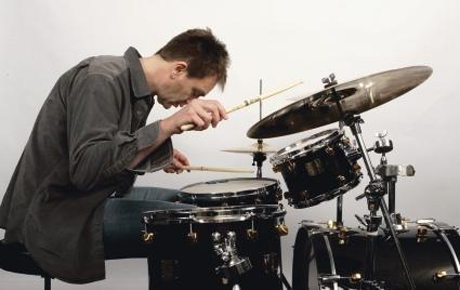
Compare the image above with the image below. The above shows the body collapsed forward, while the below image shows the torso hinging from the hips, moving forward slightly, and maintaining a physically efficient posture.

Breath
We all know that breathing is a natural activity and something that we may not consciously think about. However, it's possible that we may be interfering with our natural breathing pattern, perhaps through holding our breath when concentrating, or through holding tension and rigidity in the ribs, which stops the lungs from doing their job properly.
The best advice that Alexander Technique practitioners can give about breathing is to just let it happen - don't interfere with it. If you were to fall unconscious (don't try this at home!), you would continue to breathe - so why interfere with something the body can do perfectly well without your help?!
Here's an exercise you can try out while in a semi-supine position (more on semi-supine on the next page). First, ready, breathe out through the mouth as though you are blowing out a candle. When there is no breath left, close your lips and wait for the in breath to happen through the nose. Don't hold your breath by closing off the air passages.
It may take quite a long time for the in breath to happen, but just keep waiting and your body will breathe you! Repeat this a few times. This exercise shows that if you get out of the way, your body will do the breathing for you - one less thing to worry about so you can get on with playing the drums!
Next page: the 6 benefits of semi-supine and how to do it
Semi-supine
Lying on the ground for just 15 minutes a day is one of the most beneficial things you can do for the human body. In Alexander Technique this is known as 'semi-supine' or 'active rest'. The below image shows the body in a semi-supine position.

Warning: the following information could seriously improve your drumming…
6 benefits of Semi-Supine
1. Allows complete rest of the body.
2. Reinforces a good relationship between head, neck and back .
3. Plumps up the cushioning discs of the spine.
4. You can practise releasing muscle tension through thinking.
5. Brings mind and body together.
6. By lying in semi-supine just before practising, you will be more aware of tension in your body while playing.
How to do it
1. Lie on a carpeted surface .
2. Place a small stack of books under the head - one or two inches (so that your chin isn't at your chest but your head isn't arching backwards either).
3. Bend your knees and bring your feet comfortably close to body (legs should feel balanced and be hip width apart).
4. Rest your hands on your abdomen. What should I think about?
5. Allow your whole body to release onto the floor and feel supported by the floor.
6. Tell yourself that your head is supported by the books so your neck has nothing to do - it can really release
7. Imagine what your back looks like and let it widen and lengthen onto the floor.
8. Think about your knees pointing up to the ceiling and allow your hip joints to be free - this will help your lower back to release.
9. Let your hands mould to the shape of your abdomen by releasing them and think about your elbows sinking into the carpet - this will release the arms.
10. Allow your shoulders to drift slowly apart from each other and your shoulder blades to sink into the floor.
11. Become aware of the natural rhythm of your breathing and just let it happen.
12. Remember, don't 'do' anything, just use your thinking to achieve results. If you do semi-supine and realise you haven't done any constructive thinking, take heart; the spine is a hydraulic system that compresses throughout the day and just lying down for 15 minutes allows all the fluid to go back into the discs and 'plump up' the spine again. So, you haven't wasted your time!
Shoes off, hands on
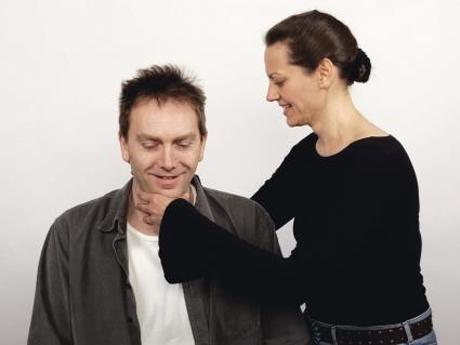
To really benefit from the Alexander Technique is to have some one-to-one lessons with a qualified teacher. During a lesson, the Alexander teacher will guide you towards better physical coordination, and help you release tension in the body.
By looking at everyday movements like sitting, standing and bending, you become aware of inefficient patterns and habits. With the teacher's help, you'll explore ways to carry out these activities without imbalance and excess effort.
The teacher will probably also work with you lying in the semi-supine position, because not having to worry about gravity helps you let go of maximum tension throughout the body. After the lesson you are likely to feel more relaxed and have a sense of lightness when you move. The above and below images show teacher Jane Gregory in action.
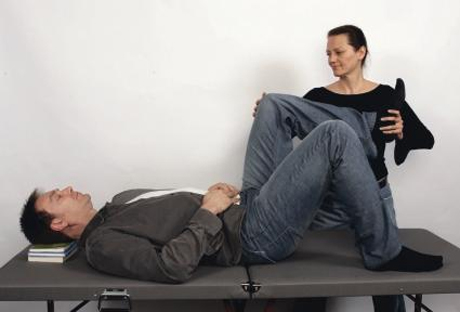
Notice that our eager recipient looks relaxed, content and, not to mention, fully clothed! Indeed, the only thing you have to cast off is your shoes, and your doubts. Try it and see.
Liked this? Then try:
How to improve posture with the Alexander Technique: part 1
17 seriously useful drum tuning tips
The 17 most outrageous drum kits on the internet
Sign up for our free weekly newsletter
The free MusicRadar newsletter serves up the week's biggest artist and product news stories alongside exclusive tuition and gear reviews. Sign up here!
Follow MusicRadar on Twitter
Get instant updates and bonus content plus chat with the team. Start here!